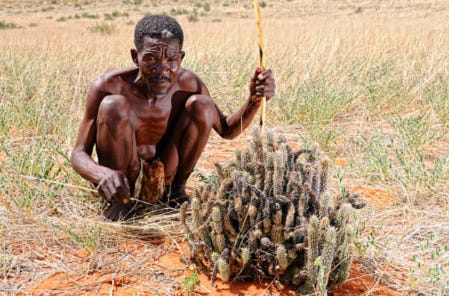A Euphorbia is Not a Cactus...
(Originally published on facebook.com/drzee.me December 14, 2024)
As a psychonaut who is interested in the sociological and anthropological aspects of altered states, I really like encountering uses of mind-altering substances in traditional societies. Especially because uses such as this are often associated with ancient episodes of cultural evolution - of the sort that were not overshadowed by Judeo-Christian morality (that dominated the last 3000 years of shaping belief systems).
Therefore, from time to time I will bring examples of less known uses of mind-altering substances - some will be new psychoactive substances while some will be very old ones.
One example of an ancient mind altering substance was used by what is likely the oldest human society on the planet - the San people of the Kalahari Desert (known colloquially as 'Bushmen')
This nation is one of the last populations in the world of hunter-gatherers (and today, only a handful of them, if any, maintain their traditional lifestyle).
The San people live in one of the harshest areas in the world, in the Kalahari Desert (in Namibia, Botswana and South Africa). For a long time, their environment isolated them from the rest of mankind, creating a kind of geographical time capsule of people who, in some ways, behaved as their ancestors did 50,000 years ago.
The Old Way- A Story of the First People
Prima facie, we wouldn't expect to find mind-altering traditions in such a society. On the one hand, life requires a lot of focus and concentration because the environment is harsh and demanding - and in such an environment, you can pay dearly for getting high. This is what makes their use of a succulent (aka 'cactiform') called Hoodia gordonii very surprising and interesting.
According to current understandings of 'mind-altering' most people would likely not classify Hoodia as a mind-altering agent, and yet, upon further reflection, we can call it nothing else
Hoodia contains an active called P57 (glycoside) that has been discovered to be a type of natural appetite suppressant. In other words, it doesn't produce any high, just a feeling of satiety (it may also inhibit fatigue). Still, yes, this is definitely an effect that can be defined as psychoactive. And why do the Bushmen of the Kalahari use it? Well, as part of their practice, they would go on hunting expeditions that lasted for many hours. Sometimes, even days in a row without a single break.
‘Persistence hunting’ (as it is called) is exhaustingly laborious, those who practice it have to move lightly and continuously - sucking on the Hoodia's flesh allows them to keep up the chase until they exhaust their quarry. This, in my opinion, is an excellent example of adopting a mind-altering effect that provides a real advantage in a downright existential situation. The medical community calls this “performance enhancement.”, and like doping in sports competitions, it is considered forbidden, unethical, or bad practice.
In the three decades (almost) that I have been involved in psychonautics, I have seen many examples of compounds that could be used beneficially and safely, allowing their users to manifest more of their potential. But in modern times, the medical community has been given both control over our health and the burden of responsibility for it. Performance enhancement is not a matter of life and death, and maximising our achievement potential is not a priority for practitioners of medicine. Denied the freedom to choose what will enter our own bodies, we compromise and live with mediocrity, obesity, and depression… that is, of course, unless you choose the way of the psychonaut:-) I




